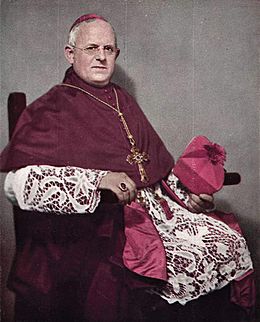Santiago Copello facts for kids
Quick facts for kids His Eminence Santiago Copello |
|
|---|---|
| Cardinal, Archbishop emeritus of Buenos Aires | |

Cardinal Copello.
|
|
| Archdiocese | Buenos Aires |
| Enthroned | 20 September 1932 |
| Reign ended | 25 March 1959 |
| Predecessor | José Bottaro y Hers |
| Successor | Fermín Lafitte (ad interim) Antonio Caggiano |
| Other posts | Chancellor of the Holy Roman Church |
| Orders | |
| Ordination | 28 October 1902 (Priest) |
| Consecration | 30 March 1919 (Archbishop) |
| Created Cardinal | 16 December 1935 |
| Rank | Cardinal-Priest of San Lorenzo in Damaso |
| Personal details | |
| Birth name | Santiago Luis Copello |
| Born | January 7, 1880 San Isidro, Buenos Aires, Argentina |
| Died | February 9, 1967 (aged 87) Rome, Italy |
| Buried | Basílica Santísimo Sacramento, Retiro, Buenos Aires |
| Nationality | Argentine |
| Denomination | Roman Catholic Church |
| Alma mater | Pontifical Gregorian University |
| Motto | Veni Domine Jesu (Come Lord Jesus) |
| Styles of Santiago Copello |
|
|---|---|
 |
|
| Reference style | His Eminence |
| Spoken style | Your Eminence |
| Informal style | Cardinal |
| See | Buenos Aires (emeritus) |
Santiago Luis Copello (born January 7, 1880 – died February 9, 1967) was an important Argentine leader in the Roman Catholic Church. He was a Cardinal, which is a very high rank. He served as the Archbishop of Buenos Aires from 1932 to 1959. In 1935, he became a Cardinal. Santiago Copello was special because he was the first Cardinal ever from Argentina. He was also the first Cardinal from Spanish-speaking America.
Contents
Santiago Copello's Journey in the Church
Santiago Copello was born in San Isidro, Buenos Aires, Argentina. He studied to become a priest at a seminary in La Plata. He also went to the Pontifical Gregorian University in Rome, Italy. On October 28, 1902, he was ordained as a priest.
From 1903 to 1918, he worked in churches in La Plata. This is called pastoral work.
Becoming a Bishop and Archbishop
On November 8, 1918, Santiago Copello became an Auxiliary Bishop of La Plata. An Auxiliary Bishop helps the main bishop. He also became a Titular Bishop of a place called Aulon.
He officially became a bishop on March 30, 1919. Bishop Juan Terrero y Escalada led the ceremony. Other bishops, Francisco Alberti and José Orzali, also helped.
On May 15, 1928, he became an Auxiliary Bishop for Buenos Aires. Soon after, on June 12, he was named Vicar General for Buenos Aires. He also became a Vicar for the Argentine military. On August 2, 1932, he was chosen as Vicar Capitular. Then, on September 20, 1932, he was appointed Archbishop of Buenos Aires. This was a very important role.
A Cardinal and Church Leader
Pope Pius XI made Copello a Cardinal-Priest on December 16, 1935. This happened during a special meeting called a consistory. He was given the title for the church of San Girolamo dei Croati. This made him the first Cardinal from Argentina and from Spanish America.
On January 29, 1936, he became the Primate of the Church in Argentina. This means he was the most important church leader in the country.
Cardinal Copello helped choose the next Pope. He was one of the cardinal electors in the 1939 papal conclave. This meeting chose Pope Pius XII as the new Pope.
In November 1945, he told Argentine Catholics not to support political parties. He did not want them to support groups that wanted to separate the Church from the government. He also opposed removing religion from public schools. He was against making civil divorce legal in Argentina. He even had a parish priest removed for criticizing President Juan Perón.
After a meeting of church leaders in 1955, he had to live in the Roman Curia for a while. This happened after the government of Juan Perón fell.
Later Years and Legacy
Cardinal Copello also helped choose Pope John XXIII in the 1958 conclave.
He stopped being the Archbishop of Buenos Aires on March 25, 1959. He had served for twenty-six years. On the same day, he became the Apostolic Chancellor. He held this job until he passed away. On December 14, 1959, he became Cardinal-Priest of San Lorenzo in Damaso.
From 1962 to 1965, he attended the Second Vatican Council. This was a very important meeting for the Catholic Church. During this time, he also helped choose Pope Paul VI in the 1963 papal conclave.
Cardinal Copello died in Rome when he was 87 years old. He is buried in the Basilica of the Holy Sacrament in Buenos Aires, Argentina. This church is located near the Kavanagh Building in the Retiro area.
See also
 In Spanish: Santiago Luis Copello para niños
In Spanish: Santiago Luis Copello para niños

